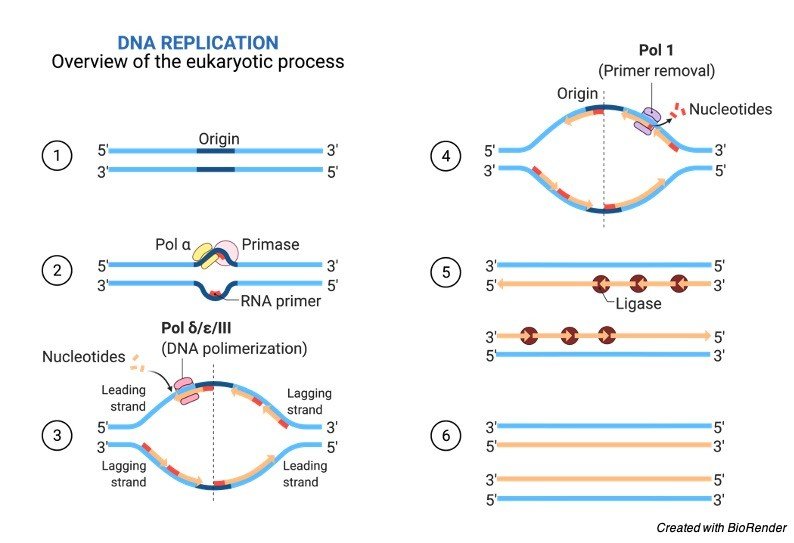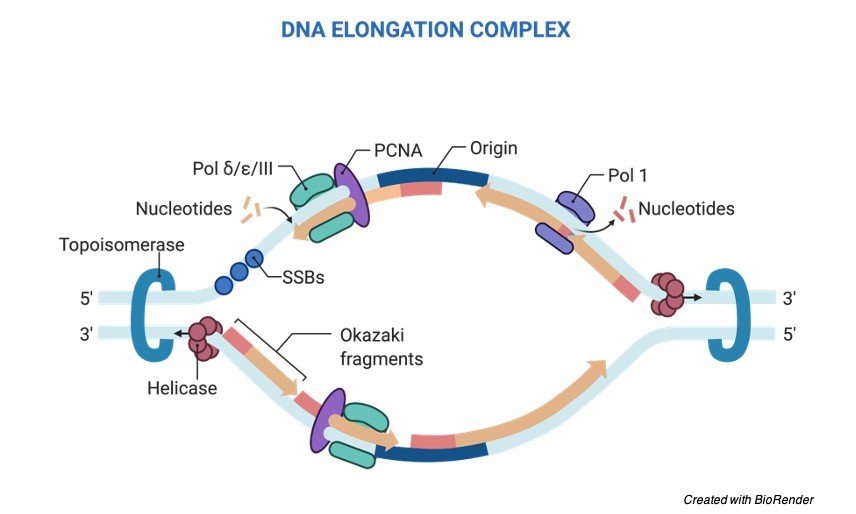About DNA and DNA Replication
We all know that DNA is a self-replicating structure. DNA replicates in a semi-conservative manner which are catalysed by the set of enzymes.
In this process the DNA makes multiple copies of itself. It is considered as a process of biological polymerization where the process consists of initiation, elongation and the termination.
This process is usually catalysed by the enzyme which mainly involves DNA polymerase which is the main element in the replication process.
We know that the Genetic material consists of a nucleic acid which is almost DNA in all organism except those of viruses. Which is considered as the storage site of all information’s, where it is stored in the form of nucleotide sequences such as sequence of amino acids, which is also referred to as genetic code.
The stored information is then copied as RNA molecules by transcription, and are translated by the process of translation. Where transcription and translation are not a direct process.
Where as proteins does not serve as a template for synthesis of proteins, but in few cases RNA acts as a template for synthesizing DNA, it is known as the central Dogma by Francis crick.
What is DNA Replication?
Genetic information present in the double strands of DNA is transmitted from one cell to another during the process of mitosis, to the offspring from the parent by the replication of parental DNA molecules.
DNA is a soiled double helical structure which exists in variety of types which serves as a risk during the replication process by imposing it to several restriction enzymes and uncoiled to form a single strand for the process of replication.
Steps in DNA Replication
This process was introduced when Watson and Crick replicated DNA as such in its Double helical structure. It is one of the complex process which involves many enzymes.

I. DNA Replication: Initiation
It is the first step involved in the process of replication. Here the parental strands are uncoiled permanently into a single stranded structure before beginning the synthesis of DNA. By this the new daughter strand is introduced in the replication fork.

II. DNA Replication: Elongation
Initiation is followed by elongation where the new complementary strands are added. The nucleotides which are added in the newly formed strands are dictated by the bases which are present as sequences on the template strand.
Like this way new nucleotides are added by the enzyme DNA polymerase from one end of the strand to the other end.
The nucleotides are namely Deoxyribonucleotide triphosphates DGTP, DATP, DTTP which are present in the cytoplasm of the cell.
III. DNA Replication: Termination
The end of the reaction is known as termination where the duplicated DNA molecules are separated as a single strand. Because the process of replicating DNA is to create two new strands which are similar to the parent molecules.
DNA Replication: Semi-Conservative
The DNA replication is semi-conservation and it was first proposed by Watson and Crick. Here it states that half of the DNA is conserved. Where half of the strand is original template which is retained form the parent and it serves as a template for the newly formed complimentary strand.
The newly formed strand is made up of hydrogen bond which connects itself to the parental strand forming a double helical structure. Thus, each of the double helical structure is made up of one parental strand and the other newly formed strand.
Enzymes Involved in DNA Replication
There are several important enzymes which take part in the process of replication, which has the ability to copy DNA molecules that has millions of bases. They perform accurate functions with high speed though it is compact. It is also been bound with proteins.
Maintaining the integrity of genetic information is the main role of replication process. Where as in Escherichia coli two enzymes play a role in the process of replication. They are namely DNA polymerase I and DNA polymerase II which involves in the repairing process of DNA. And the other enzymes such as DNA polymerase IV and DNA polymerase V are involved in adding the nucleotides, almost thousand of nucleotides are added per second.
DNA Dependent DNA Polymerase
These enzymes help in polymerization and catalyses the process of DNA replication with the help of other enzymes.
Deoxyribonucleosides are energy providers along with the role of acting as substrates.
DNA polymerase is classified as three types.
I. DNA Polymerase I
It is considered as one of the DNA repair enzymes which is involved in the following activities.
5’-3’ polymerase activity
5’-3’ exonuclease activity
3’-5’ exonuclease activity
II. DNA Polymerase II
This enzyme is responsible for proof reading and for primary extension.
III. DNA Polymerase III
This enzyme is responsible for DNA replication in vivo.
DNA Helicase
This enzyme helps in unzipping the DNA strands. This process is carried out by breaking the hydrogen bonds present between them. Which results in formation of a replication fork.
DNA Ligase
Ligase helps in sticking the DNA strands which are discontinuous.
DNA Primase
This enzyme plays an important role in synthesising the RNA primer, which is complementary to the template strand of DNA.
Endonuclease
This enzyme helps in cleaving the single or double stranded DNA.
Single Stranded Binding Proteins
This enzyme helps in binding the single stranded DNA which protects it from forming other secondary structures.
Importance of DNA Replication
DNA replication is one of the important biological processes which helps in producing two identical replicas of DNA from the one parental molecule.
It also acts as a most important part of biological inheritance which is helpful during the growth and repair phases of cell division.
It also checks that whether all new cells receive an appropriate copy of DNA. As the cell makes the distinctive property of cell division the replication process is very much important.
DNA replication helps in distributing the same copies of DNA within the gene through all cells of the body. Which helps the body to have same genetic material throughout the body.
Where as in lower organisms replication is used to have the same genes in their progeny during the reproduction.
DNA Replication
- DNA replication initiation. Methods Mol Biol . 2009;521:3-17.
- Eukaryotic chromosome DNA replication: where, when, and how? Annu Rev Biochem . 2010;79:89-130.
- Exploiting DNA Replication Stress for Cancer Treatment. Cancer Res . 2019 Apr 15;79(8):1730-1739.
- DNA replication origins-where do we begin? Genes Dev . 2016 Aug 1;30(15):1683-97.
- Mechanisms of DNA replication termination. Nat Rev Mol Cell Biol . 2017 Aug;18(8):507-516.
- Origins of DNA replication. PLoS Genet . 2019 Sep 12;15(9):e1008320.
Share









